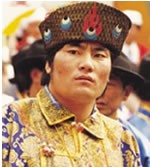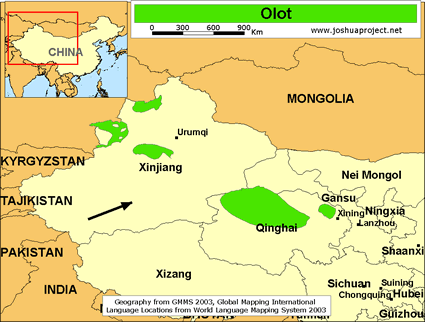In 1758 the Qing Dynasty rulers of China conquered Jungaria in today's Xinjiang Uyghur Autonomous Region. Jungaria was an area controlled by Oirat tribal chiefs who proved to be a thorn in the side of the Manchu emperors. The Manchu government transferred a group of Olot to Manchuria, where they were split up and sent to the two locations they still inhabit today. One group was placed in Nonni and the other in Imin in Inner Mongolia. The Imin group gradually lost the use of their mother tongue, having been "influenced by the local Mongolic languages and dialects."
Although officially included as part of the Mongol nationality by the Chinese authorities, the Olot consider themselves to be a separate ethnic group. They speak a tribal dialect of Oirat that is unintelligible with the languages of all other surrounding communities. Oirat is the language spoken by most Mongols in northwest China on the opposite side of the country. In Xinjiang the Torgut, Olot, Korbet, and Hoshut peoples are known as the "Four Tribes of Oirat."
The national drink of Mongolians across China is a fermented mare's milk called airag or kumiss. Made the same way today as it has been, for centuries, the milk is hung in a goatskin bag and stirred with a wooden stick until it sours. The Olot have been isolated from other Mongolian groups for such a long period that their culture today appears more similar to the cultures of the Daur and Han Chinese than to that of the Mongolians.
The majority of Olot are shamanists. Tibetan Buddhism has not gained a foothold among them as it has among most other Mongol groups. Each Olot village has a shaman who mediates between the spirit world and the community. The shamans were persecuted during the 1960s but have reappeared in the 1980s and 1990s.
No Olot are known to have ever believed in Christ, although a strong Daur church has emerged in recent years and may be able to take the gospel to the neighboring Olot. For the time being the Olot remains an untouched people group.
Without the guidance of Christ, these people are like sheep without a shepherd. They need the good shepherd in their families and communities.
Pray for the spiritual blindness and bondage to the evil one to be removed so they can understand and respond to Christ.
Pray for the Lord to provide for their physical and spiritual needs as a testimony of his power and love.
Pray that the Olot people will have a spiritual hunger that will open their hearts to the King of kings.
Pray for an unstoppable movement to Christ among them.
Scripture Prayers for the Olot in China.
Operation China, Asia Harvest, Copyrighted © Used with permission
| Profile Source: Joshua Project |











